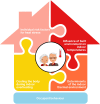Indoor overheating: A review of vulnerabilities, causes, and strategies to prevent adverse human health outcomes during extreme heat events
- PMID: 39193048
- PMCID: PMC11346563
- DOI: 10.1080/23328940.2024.2361223
Indoor overheating: A review of vulnerabilities, causes, and strategies to prevent adverse human health outcomes during extreme heat events
Abstract
The likelihood of exposure to overheated indoor environments is increasing as climate change is exacerbating the frequency and severity of hot weather and extreme heat events (EHE). Consequently, vulnerable populations will face serious health risks from indoor overheating. While the relationship between EHE and human health has been assessed in relation to outdoor temperature, indoor temperature patterns can vary markedly from those measured outside. This is because the built environment and building characteristics can act as an important modifier of indoor temperatures. In this narrative review, we examine the physiological and behavioral determinants that influence a person's susceptibility to indoor overheating. Further, we explore how the built environment, neighborhood-level factors, and building characteristics can impact exposure to excess heat and we overview how strategies to mitigate building overheating can help reduce heat-related mortality in heat-vulnerable occupants. Finally, we discuss the effectiveness of commonly recommended personal cooling strategies that aim to mitigate dangerous increases in physiological strain during exposure to high indoor temperatures during hot weather or an EHE. As global temperatures continue to rise, the need for a research agenda specifically directed at reducing the likelihood and impact of indoor overheating on human health is paramount. This includes conducting EHE simulation studies to support the development of consensus-based heat mitigation solutions and public health messaging that provides equitable protection to heat-vulnerable people exposed to high indoor temperatures.
Keywords: Extreme heat events; built environment; climate change; dwellings; heat balance; heat stress; thermoregulation.
© 2024 The Author(s). Published by Informa UK Limited, trading as Taylor & Francis Group.
Conflict of interest statement
No potential conflict of interest was reported by the author(s).
Figures








References
-
- Mora C, Dousset B, Caldwell IR, et al. Global risk of deadly heat. Nat Clim Chang. 2017;7:501–506. doi: 10.1038/NCLIMATE3322 - DOI
-
- Santamouris M. Analyzing the heat island magnitude and characteristics in one hundred Asian and Australian cities and regions. Sci Total Environ. 2015;512–513:582–598. - PubMed
Publication types
LinkOut - more resources
Full Text Sources
Other Literature Sources
Research Materials
